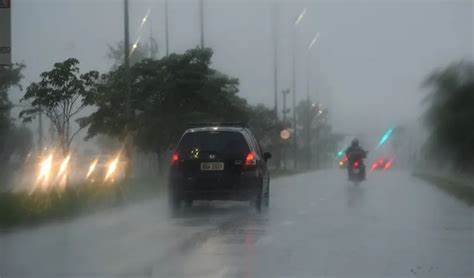Chuvas SP: Understanding the Rainy Season and Its Impact in São Paulo
São Paulo, Brazil, is a vibrant city known for its economic power, cultural diversity, and dynamic urban landscape. However, one of the most defining aspects of the region’s climate is its rainy season, known as chuvas (rains) in Portuguese. These rains have a significant impact on daily life, urban infrastructure, and the environment. This article explores the causes of chuvas in São Paulo, their seasonal patterns, and the effects they have on the city.
The Climate of São Paulo: A Quick Overview
São Paulo experiences a tropical climate, characterized by distinct wet and dry seasons. The rainy season, or chuvas, typically occurs between the months of October and March. During this time, the city experiences increased rainfall, with the heaviest showers usually taking place from December to February. These rains are essential to the local ecosystem, replenishing water supplies and nourishing vegetation, but they can also cause disruptions if not managed properly.
Causes of Chuvas SP
The rains in São Paulo are largely influenced by the region’s geographical location and its interaction with various atmospheric systems. São Paulo is situated in a tropical zone, which makes it susceptible to moisture-laden winds from the Atlantic Ocean. These winds, combined with the local topography, cause the formation of rainstorms. The hot and humid conditions during the summer months further contribute to the frequency and intensity of rainfall.
Another factor contributing to the chuvas in São Paulo is the presence of cold fronts. These fronts bring moist air from the southern regions, which can cause rainfall when they collide with the warmer air mass in the city. Additionally, the phenomenon known as the South Atlantic Convergence Zone (SACZ) can also affect the frequency of rainfall, particularly during the wet season.
Impact of Chuvas SP on Urban Life
While chuvas are a vital part of the natural environment in São Paulo, they also present several challenges to the urban infrastructure and daily life. One of the most significant impacts is on traffic. Heavy rain can cause flooding on the streets, leading to road closures and traffic congestion. São Paulo’s transportation system, including buses and trains, often experiences delays due to rain-related disruptions. This can create significant inconvenience for commuters and contribute to longer travel times.
Flooding is another common consequence of the rainy season in São Paulo. The city’s drainage systems, which were designed to handle typical rainfall, can sometimes be overwhelmed during heavy downpours. This can lead to flash floods, causing property damage, and even posing a risk to public safety. In extreme cases, flooding can lead to landslides in hilly areas, particularly in the outskirts of the city.
Environmental Effects of Chuvas SP
While the rains are crucial for replenishing water supplies and maintaining the biodiversity of the region, excessive rainfall can also have negative environmental effects. One of the primary concerns is deforestation. The increased rainfall can exacerbate soil erosion, particularly in areas where forests have been cleared for urban development. This can lead to the degradation of the environment, including the loss of natural habitats for wildlife.
On the other hand, chuvas are essential for maintaining São Paulo’s water reservoirs. The city relies heavily on rainfall to fill its reservoirs, which supply the majority of its drinking water. The rainy season plays a critical role in ensuring that these reservoirs are adequately stocked, especially during periods of drought when water availability becomes scarce. Thus, the regular rains in São Paulo are closely linked to the city’s water security.
Preparing for Chuvas SP
In response to the challenges posed by the rainy season, the local government has implemented various measures to mitigate the effects of chuvas. One of the most important initiatives is the improvement of the city’s drainage system. By upgrading infrastructure and expanding the capacity of rainwater drainage, São Paulo can better manage heavy rains and reduce the likelihood of flooding.
Additionally, public awareness campaigns are conducted to educate residents about the importance of flood prevention, waste management, and protecting the environment. The government also works with urban planners to ensure that future developments are more resilient to flooding and the impact of extreme weather events.
FAQs
What are chuvas in São Paulo?
Chuvas is the Portuguese term for rains, referring to the rainy season in São Paulo, which generally occurs between October and March. During this period, the city experiences higher-than-usual rainfall, particularly from December to February. These rains are vital for replenishing water supplies, but they also present challenges related to flooding and transportation.
Why does São Paulo experience chuvas?
São Paulo’s geographical location in a tropical zone makes it susceptible to moisture-rich winds from the Atlantic Ocean. These winds, combined with the region’s topography, create conditions conducive to heavy rainfall. Additionally, cold fronts and the South Atlantic Convergence Zone (SACZ) contribute to the intensity and frequency of the rains during the wet season.
How do chuvas affect daily life in São Paulo?
While chuvas are essential for the environment, they can disrupt everyday activities in São Paulo. Heavy rainfall often leads to flooding, especially in areas with inadequate drainage systems, which can result in traffic congestion, road closures, and public transportation delays. The rain can also overwhelm stormwater drains, causing flash floods in some areas.
What impact do chuvas have on the environment?
The rains are beneficial for the environment, replenishing water reservoirs that supply the city’s drinking water. However, excessive rainfall can contribute to soil erosion, particularly in deforested areas. Additionally, flooding and landslides in hilly regions can damage natural habitats and cause long-term environmental degradation.
To Conclude
The chuvas in São Paulo are a defining characteristic of the city’s climate, bringing both benefits and challenges. While they are crucial for the environment and the city’s water supply, they can also disrupt daily life and cause significant infrastructure issues. As the city continues to grow, it is essential to invest in sustainable urban planning, improved infrastructure, and community awareness to ensure that São Paulo can effectively manage its rainy season and reduce the negative effects of chuvas.
To read more, Click Here


